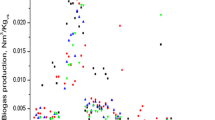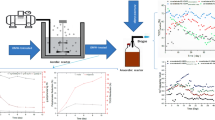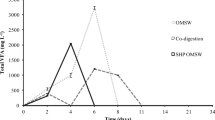Abstract
The high organic content of Olive Mill Wastewaters (OMW) causes some difficulties in maintaining the anaerobic process efficiency at high level. The two phase anaerobic system was used to treat olive mill wastewaters, diluted with tap water. Phase separation was accomplished through control of the hydraulic retention time and initial COD removal in two reactors operated in series. The effect of substrate concentration and phase separation on removal efficiency has been investigated. Experimental results indicated that yield of 0.322 to 0.335 litre biogas/g COD removal were obtained with two phase anaerobic treatment and space loading rate of 2.3 and 2.4 gCOD/l.day. The maximum methane production rate near to the theoretical value and corresponded to 360 ml of CH4 for 1g COD removal.
Similar content being viewed by others
Abbreviations
- OMW:
-
Olive Mill Wastewaters
- VFA:
-
Volatile Fatty Acid
- COD:
-
Chemical Oxygen Demand
- HRT:
-
High Retention Time
- TKN:
-
Total Kjeldahl Nitrogen
References
Boari, G.; Brunetti, A.; Passino, R.; Rozzi, A.: Anaerobic digestion of olive oil mill wastewaters. Agricultural. Wastes 10 (1984) 161–175
Tsonis, S. P.; Grigoropoulos, S. G.: High rate anaerobic treatment of olive oil mill wastewater. Proceedings of fifth Intern. Symp. on Anaerobic Digestion, Bologna. In: Hall, E. R.; Hobson, P. N. (Eds.), pp. 115–124 (1988)
Balice, V.; Boari, G.; Cera, O.; Abbaticchio, P.: Indagine analitica sulle acque di vegetazione. Nota 1. Inquinamento 7 (1982) 49–53
Flemming, H. P.; Etchells, J. C.: Occurrence of an inhitor of lactic acid bacteria in green olives. Appl. Microbiol. 15 (1967) 1187–1192
Saiz, J. C.; Gomez, A. G.: Vegetation water treatment by aerobic fermentation with fungi. Simposio International sobre valorizacion de los subproductos del olivar: alpechin y orujo. 5-6-7 Marzo, sevilla. Espana, pp. 48 (1986)
Balice, V.; Carriere, C.; Cera, O.; Rindone, B.: The fate of tannius-like compounds from olive mill effluent in biological treatment. Proceedings of fifth Intern. Symp. on Anaerobic Digestion. Bologna. In: Hall, E. R.; Hobson, P. N. (Eds.) pp. 275–279 (1988).
Hamdi, M.; Khadir, A.; Garcia J. L.: The use of Aspergillus niger for the bioconversion of olive mill wastewater. Appl. Microbiol. Biotechnol 34 (1991) 828–831
Fiestas Ros de Ursinos, J. A.: Differentes utilisations des margines. In: Proc. of Séminaire International sur la valorisation des sous-produits de l'olivier. FAO-PNUD. Tunisie pp 93–110 (1981)
Fiestas Ros de Ursinos, J. A.; Navarro Gamero, R.; Leon Gabello, R.; Garcia Buendia, A. J.; Mastrojuan Saez de Jauragui, G. M.: Depuracion anaerobia del alpechin como fuenta de energia Grasas Aceites, 33 (1982) 265–270
Pohland, F. G.; Ghosh, S.: Anaerobic stabilization of organic wastes, two-phase concept. Envir. Litt. 1 (1971) 255–266
Fan, L. T.; Erickson, L. E.; Balles, J. C., Shah, P. S.: Analysis and optimisation of two-stage digestion J. Water Pollut. Contr. Fed., 45 (4) (1973) 591–610
Ghosh, S.; Conrad, J. R.; Klass, K. L.: Anaerobic acidogenesis of wastewater sludge. J. Water Pollut. Contr. Fed., 47 (1) (1975) 30–44
Massey, M. L.; Pohland, F. G.: Phase separation of anaerobic stabilisation by kinetic controls. J. Water Pollut. Contr. Fed., 50 (9) (1978) 2204–2222
Balch, W. E.; Fox, G. E.; Magrum, L. J.; Woese, L. R.; Wolfe, R. S.: Methanogens: Reevaluation of a unique biological group. Microbiol. Rev., 43 (1979) 260–296
Ross Knechtel, J.: A more economical method for the determination of oxygen demand. Water Pollution Control, May/ June, (1978) 24–28
APHA: Standard methods of the examination of water and wastewater, 15th Edition. American Public Health Association, American Water Work Association, Water Pollution Control Federation, Washington, DC. (1980)
Fedorak, P. M.; Hrudey, S. E.: The effects of phenol and some alkyl phenolics on batch anaerobic methanogenesis. Water Res. 18 (1984) 357–361
Hamdi, M.: The effects of pretreatment and agitation on the batch anaerobic digestion of olive mill wastewaters. Bioresource Techno. 36 (1991) 173–178
Thauer, R. K.; Jungermann, K.; Decker, K.: Energy conservation in chemotrophic anaerobic bacteria. Bact. Rev. 41 (1977) 100–180
Martin, A.; Borja, R.; Garcia, I.; Fiestas, J. A.: Kinetics of methane production from olive mill waste-water. Process Biochem. 26 (1991) 101–107
Cail, R. G.; Barford, J. P.: Thermophilic semi-continous anaerobic digestion of palm-oil mill effluent. Agrical. Waste 13 (1985) 295–304
Sayadi, S.; Ellouz, R.: Decolorization of olive mill wastewater by the white rot fungus Phanerochate chrysosporium involvement of the lignin degrading system. Appl. Microbiol. Biotechnol. 37 (1992) 813–817
Author information
Authors and Affiliations
Rights and permissions
About this article
Cite this article
Gharsallah, N. Influence of dilution and phase separation on the anaerobic digestion of olive mill wastewaters. Bioprocess Engineering 10, 29–34 (1994). https://doi.org/10.1007/BF00373532
Received:
Issue Date:
DOI: https://doi.org/10.1007/BF00373532




